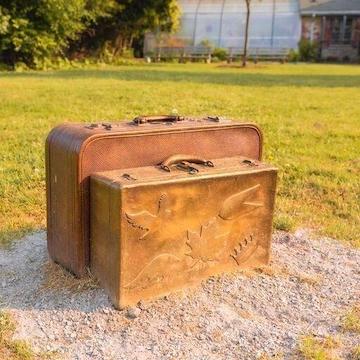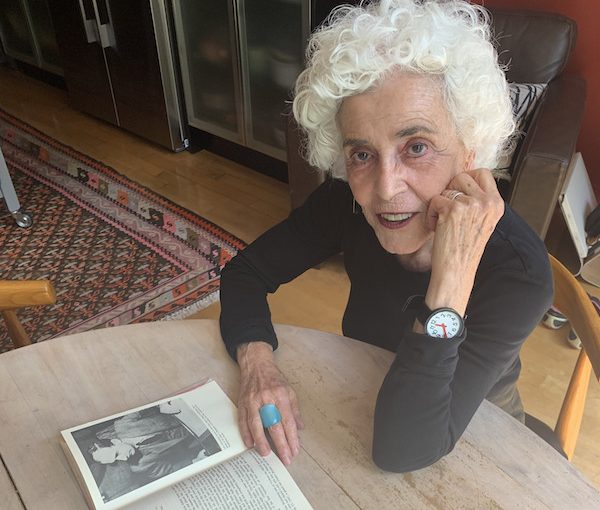Yvonne Singer (photo by Ron Csillag)
As an artist herself, Yvonne Singer can well appreciate the esthetic merits of the open-air monument to Swedish Second World War hero Raoul Wallenberg that was unveiled last June at Churchill Park in Hamilton, Ont., in a ceremony attended by those whose families owed their survival to Wallenberg.
Though she has not personally viewed the installation, called “Be:longings,” Singer spoke admiringly of the 10 bronze-cast suitcases dispersed along a gravel path adjacent to the Hamilton aviary. She knows Simon Frank, one of the project’s three creators, and is aware that suitcases are a potent symbol of the Holocaust.
“I like the fact that the suitcases are scattered,” Singer, a well-established visual artist and teacher in Toronto, said in an interview over lemon tea in her sun-drenched kitchen. “I think the imagery and symbolism are very effective in conveying the idea of displacement and emigration.”
The old-timey valises evoke not just Wallenberg, Singer noted, but all victims and survivors of that terror-stricken era. The outdoor project is also “minimal, which I like. I don’t like public sculptures that scream at you or are clichéd.”

Singer connects to the installation on a whole other level. The 78-year-old resident of Toronto’s trendy Cabbagetown neighbourhood is Wallenberg’s goddaughter. She was born on his bed.
It’s a Hollywood-worthy tale that evolved over time, in a series of eye-popping twists, turns and coincidences – all amid Singer’s own personal voyage of self-discovery.
The backstory is its own blockbuster: The non-Jewish scion of a wealthy Swedish industrial and banking family, Wallenberg, then just 32, was recruited by the US War Refugee Board and dispatched to Budapest to assist and rescue as many Jews in the Nazi-occupied Hungarian capital as possible. He arrived in July 1944, just as the Nazis had finished shipping some 440,000 Jews from the countryside to Auschwitz. They and their Hungarian collaborators, the Arrow Cross militia, now set their sights on the Jews of Budapest.
Accorded diplomatic status, Wallenberg famously set off on a frenetic pace. He designed, printed and distributed thousands of the famous “Schutzpass” – an official-looking document that placed the holder under the protection of the neutral Swedish Crown. He also scoured the city for buildings to rent, finding 32, and crammed in as many souls as possible. The “safe houses” flew the yellow-and-blue Swedish flag and were declared protected by diplomatic immunity.
Known for his bluster and bravado (and for bribes using American cash), his greatest coup came when he reportedly persuaded Nazi commanders to call off the liquidation of Budapest’s Jewish ghetto, with its 70,000 inhabitants.
The number of Jews Wallenberg is said to have rescued peaks at 100,000. He is credited with saving more Jewish lives during the war than any single government.
By January 1945, the Red Army was laying siege to Budapest, and Wallenberg was taken into custody on allegations he was a US spy. He promptly vanished into the massive gulag system. A Soviet report in 1956 dryly noted he had died in July 1947 of a heart attack in Moscow’s notorious Lubyanka prison, but supposed eyewitness sightings and stories of contact with him from former inmates continued well into the 1970s.
A nine-year joint Swedish-Russian investigation, ending in 2001, came to opposing conclusions, with Moscow sticking to its story about Wallenberg’s 1947 death, and Stockholm stating that absent any proof, it was impossible to reach a conclusion about his fate.
In 2012, the diaries of a former head of the KGB, discovered stuffed into the walls of his Moscow home, stated there was “no doubt” that Wallenberg was “liquidated” in 1947.
But back to Singer.
On the night of Nov. 3, 1944, a desperate Tibor Vandor, who worked for Wallenberg as a courier and liaison to the underground, needed help for his wife, Agnes. She was in labour and had been turned away from Budapest’s hospitals, which barred Jews. Wallenberg allowed the couple to use his own room, while he slept in the corridor using his coat as covers.
The next morning, he was called in to see a dark-haired newborn girl. Asked by the grateful parents to name her, Wallenberg chose Nina Maria Ava (Nina was his half-sister’s name, Maria his mother’s). The couple changed the first name to Yvonne, and Wallenberg agreed to be the child’s godfather.
Singer knew nothing of this until she was 34 years old.
It was October 1979 when she read an article in the Toronto Star, reprinted from a US newspaper, about Wallenberg’s plight. The story included a reference to Singer’s unusual birth, taken from a Hungarian book on the Swedish hero written after the war. The baby with the Toronto connection, the parents, the godfather, were all there, mentioned by name.
When she read the piece, “I burst out crying,” she told the Star after contacting the paper. Her story spilled forth a week later in a large Saturday article headlined “Swedish hero saved my life: Metro woman.”
Singer is still struck by “the incredible coincidence of it all. Here I am in Toronto in 1979, reading the paper … it boggles the mind. I could have easily gone through life not knowing the story. Suddenly, I had a connection to this man, who sounds like he was fascinating.”
Her parents had not told her the story. And there was another missing piece of the puzzle: their Jewishness.
At war’s end, the Vandors went to Switzerland and Holland before settling in Montreal in 1949, where they shed their Jewish identities, doubtless seeking to blot out the legacy that had caused them so much pain. Tibor Vandor even became an elder in the United Church (Yvonne attended church until she was about 14).
Her parents never revealed being Jews. “I always pressed them for more information, and they always refused,” even following the revelations in the Toronto Star, Singer recalled. “They told me very, very little.” Their silence encompassed “anything to do with the war.”
Singer graduated from McGill University and went on to teach high school English and French. She married her husband, Ron Singer, a theatre director and educator, in 1966 and, because her Jewishness was unknown to her, converted to Judaism.
A few years later, a cousin in England recalled being a flower-girl at Yvonne’s parents’ wedding, which she said took place in a synagogue. The parents denied it, but Yvonne believed it.
Singer’s feelings of alienation as an immigrant child would evaporate on discovering that she had been born Jewish, whether the knowledge came from a cousin or the Toronto Star. “I felt like I’d come home, part of a history that goes back thousands of years. I no longer felt rootless,” she said.
The Singers moved to Toronto in 1971, where Yvonne later began a prolific art career in various media and teaching visual arts at York University. Raising three daughters and a busy life meant there was little time to get involved in the Wallenberg file, though she was pleased when he became Canada’s first Honorary Citizen in 1985 and when Canada Post issued a stamp commemorating Wallenberg a decade ago.
In 1997, even Queen Elizabeth heard Singer’s remarkable story. The artist was among the dignitaries in London when a bronze statue of Wallenberg was unveiled by the Queen. The two were introduced.
“The Queen listened attentively and I was told she was very interested in my story,” Singer said at the time. “It was a highlight of my life.”
It’s no surprise that Singer’s art has explored themes of identity, history and memory. The outsider status she felt in her early life “is what made me think about ways of expressing that, either through language or visual imagery. So, you go to what you know when you’re an artist.”
In 2016, the Swedish government declared Wallenberg officially dead, but, to Singer, that offered no finality. “From what I learned, the Swedish government is not exempt from blame for trying to get Wallenberg out. I cannot reconcile the fact that [Wallenberg’s family] could not exert any kind of leverage over the Russians to find out what happened to him.”
The title of godparent in Judaism is largely honorary, and Singer considers the godfather connection to Wallenberg an honour. “But I’m also very sad that I never met him,” she said. “I think he would have been a fascinating person to talk to. The story is just very, very tragic.”
The grandmother of nine sighed. Over the decades, the story for her was very personal, obviously, “and I was still processing it. Maybe I’m still processing it, for a long, long time.”
A version of this article originally appeared in the Hamilton Jewish News. It is reprinted with the author’s permission.

